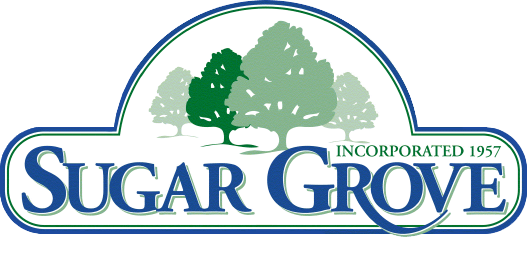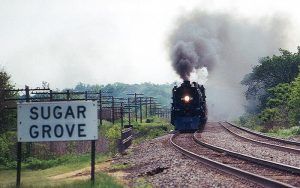Online Utility Bill Payment - Click here for details
History of Sugar Grove
Sin-Qua-Sip
Sin- Qua-Sip,” the Native American name for Sugar Grove, had its beginning in the Spring of 1834 at what is now known as Bliss Woods Forest Preserve. Six men, coming from different areas of the east, met at Black Swamp, Ohio, and decided to journey west together. These men, Asa McDole, James and Issac Isbell, their nephew Parmeno Isbell, James Carmen and Mr. Bishop, were the founding fathers of Sugar Grove. At this time, the area was populated by Native Americans, hence when these men arrived, they found an abandoned Native American sugar camp where they took shelter in a brush wigwam, until they were able to build their first log cabin. In 1835, the first white women to arrive were the mother and sister of James and Issac and their brother Lyman and his wife who arrived in the spring of 1835.
In 1839 and the 1840’s, the United States Surveyors came to survey and layout the section lines. These sections were one square mile and were sold at an auction in Chicago in 1842 for $1.25 an acre.
The Village of Sugar Grove was incorporated in 1957 with a population of 125. At that time, municipal offices were located in the basement of the Community House. Sugar Grove remained predominantly a farming community until the early 1960’s when residential development began on the east side of Route 47. Development continued on the west side of Route 47 throughout the 1970’s, with annexation of Dugan Woods subdivision occurring in 1977. Development of the Windstone, Black Walnut Trails, Strafford Woods, Mallard Point, and Chelsea Meadows subdivisions began in late 1980’s and has continued into the late 1990’s. The late 1990’s into the early 2000’s saw the development of Windsor Pointe and the Walnut Woods Subdivision.
Under a newly adopted State Constitution, the first town meeting in Sugar Grove was held April 2, 1850 at the home of S.G. Paull, at the southwest corner of Bliss Road and Route 47. The 1850 Census lists 136 families and 720 people in the township. The Annual Meetings were held at the Town House north of Sugar Grove. After it burned in 1874, it was built in present day Sugar Grove, on Main Street, where the Community House now stands.
Electricity came to town in 1925. The Northern Illinois Gas pipelines were laid out in 1963. The water system was a private system, owned by Kitty Lorah, and evolving from the Old Hotel. Pipes were in the ground and the billing was just a rate paid to Mrs. Lorah. In 1948, the Sugar Grove Water District was formed. Well #1 was dug behind the fire house on Main Street and pipes were laid to all homes within the Village.
The Village was incorporated in 1957 with the sewer system being installed in 1974. By this time the Village had assumed control of the water system, and Well #2 was dug and the water tower was erected. .The phones originally were connected by an operator living in the Old Hotel, then in a residence on Maple Street and later on the second floor of Keck’s Store. The first switching building was located behind Keck’s Store. The present day building was built on Main Street north of Cross Street in 1983.
When the first settlers arrived, transportation was limited to old Native American trails. The dirt roads which were laid out by the 1860’s were paved during the period 1920-1960. The present day Sugar Grove was established at its present site, when the Chicago and Iowa Railroad was platted in 1871. The depot was located in the Old Hotel until a building was provided by the railroad. The Chicago, Burlington, and Quincy Railroad bought the Chicago and Iowa Railroad in 1881. A stock yard to load cattle was south of Main Street. This railroad was an essential link for farmers and their agricultural business as well as providing transportation for the residents of the community. In 1970, the Burlington Northern was formed when the CB&Q merged with several western railroads. When Amtrak took over passenger service, they discontinued passenger trains on this track. The depot was torn down in the 1970’s. In 1996, the Burlington Northern merged with the Santa Fe and the railroad is now known as the Burlington Northern Santa Fe Railroad (BNSF).
The topography of Sugar Grove-prairie, timber and water made it ideal for farming, which was the first real business in the Township. On the busiest east-west roadway, Chicago to Dixon, in 1833, the first tavern/inn was opened. A sawmill and dam was built by Asa, Rodney and Jesse McDole in 1836, but was washed out in 1857 and moved to Iowa. In 1839, P.Y. Bliss opened a merchandise store at the corner of Bliss and Merrill Roads which drew trade form Dundee, Yorkville, Shabbona, and the eastern edge of Kane County. Dairying was an important business for numerous years. A cheese factory was located on the corner of Galena and Densmore Roads in 1866. It was awarded a blue ribbon for its cheese at the World’s Columbian Exposition in 1893. Col. Ingham’s farm (on Galena Blvd.) also had a cheese factory. The grain elevator, offices, lumber, grain and coal businesses were located south of the tracks. J.S. Miller’s store, just north of the tracks, housed an ice cream parlor, a pool hall, and the Post Office at one time. In 1893, Will E. Keck and a few others formed the Sugar Grove Supply Co. Items from hardware to food could be purchased. The business was in the Keck family until 1980.In the early 1890’s, Kitty Lorah owned Uncle Tom’s Cabin (Old Hotel). Her Sunday and family style dinners drew people from al around the area. Another eating establishment, the House of Plenty, was built in 1961 and is still in operation today as the Fireside Grille. The Bank of Sugar Grove (now Old Second) opened in February 1975.
The history of education in Illinois first approached in the year 1787 when an ordinance consecrated 1/36 of Illinois soil to common schools. The first law to go into the statutes of this state (1818) gave 3% of all rest of the land to education. In 1836 Mr. H.B. Densmore helped build a log house near the corner of Denny and Bliss Roads to be used as a school. He taught there for a time. This one burned down, and another was constructed just east of there, and was known as the Valley View School or Denny School. This one room school was to become one with the longest history of any of the numerous schools in the Township. By 1878 there were seven schools in the Township. A need for a school of higher education for the children of the area, became reality due to the vision and hard work of Thomas Judd and Professor Frank Hall. The Sugar Grove Normal and Industrial School opened for classes in the fall of 1875 with an enrollment of 100 students. This frame building burned to the ground in January of 1905 and was rebuilt of brick on the site. Students completing the course of study at this school were qualified to teach. With the consolidation of 1949, the school was incorporated into the newly formed Kaneland Community Unit School District 302, where students today are enrolled at a central campus near Maple Park. The idea of a junior college for the area started in 1961. The Junior College Act of 1965 motivated the establishment of Community College District and in the Fall of 1967 classes were held in local high schools, churches and civic buildings in surrounding communities. The Waubonsee Community College Campus was opened for classes in 1969.Sugar Grove Fire Protection District was organized July 9, 1942 as a volunteer organization.
In August 1972, thirteen women became active firewomen. This was the first fire department in the Midwest to have women as active firewomen.
Homes provided the first place of worship. The Methodists held their first quarterly meeting in 1839 in the frame house built by P.Y. Bliss at the corner of Bliss and Merrill Roads. Today, there are several churches in the Sugar Grove area providing numerous services for the community.
Administration/Finance
160 S. Municipal Drive, Suite 110
Sugar Grove, IL 60554
P 630-391-7200 F 630-391-7210
Hours 8:00 a.m. to 4:30 p.m.
Police
10 S. Municipal Drive
Sugar Grove, IL 60554
P 630-391-7250 F 630-391-7266
Hours 8:00 a.m. to 4:30 p.m.
Community Development
601 Heartland Drive
Sugar Grove, IL 60554
P 630-391-7220 F 630-391-7245
Hours 8:00 a.m. to 4:30 p.m.
Public Works
601 Heartland Drive
Sugar Grove, IL 60554
P 630-391-7230 F 630-391-7245
Hours 8:00 a.m. to 4:30 p.m.
Economic Development
601 Heartland Drive
Sugar Grove, IL 60554
P 630-391-7240 F 630-391-7245
Hours 8:00 a.m. to 4:30 p.m.
©2021 Sugar Grove








